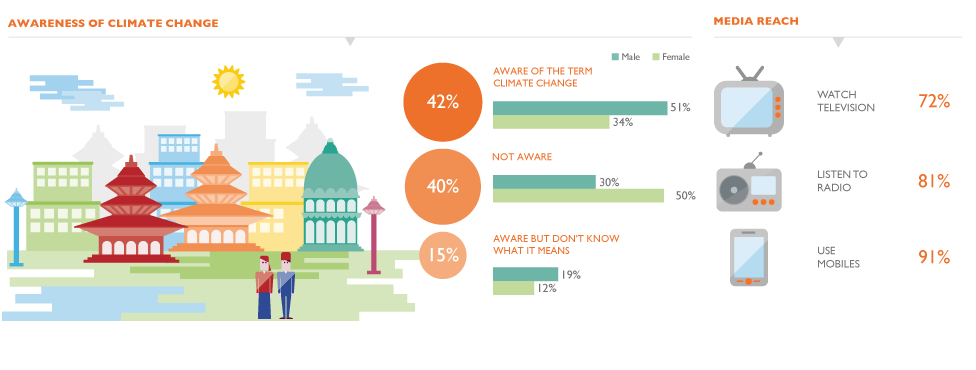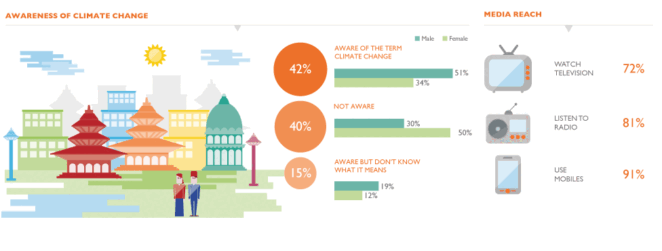Perceptions of Climate Change in Nepal

The Climate Asia project
Climate Asia is the largest ever study of people’s experience of climate change in seven countries – Bangladesh, China, India, Indonesia, Nepal, Pakistan and Vietnam – involving the collection and analysis of survey data from over 33,500 people. This unique data provides information for governments, donors, the media, NGOs and everyone who wants to support people to adapt to the changing environment.
Country Infographic

Context
The impact of climate change is a huge issue in Nepal, where over 19 million people live off the land. People feel that crop productivity has decreased because of changes in seasons, unpredictable rainfall, drought and floods.
Of the seven Climate Asia countries, people living in Nepal are the most worried about the future effects of changes in climate. News in the media has helped to contribute to this worry.
People want to make changes to improve their agricultural production, prepare more for floods and droughts, deal with water shortages and preserve their environment but are finding it difficult to act. They feel that the government should act more, that they do not have the financial resources to take action, and that they lack sufficient and relevant information.
Our research showed that being able to make decisions as a community, exposure to information and discussing how to respond all help to equip people to be able to take action.
Communication
The poorest people in Nepal feel the least informed about how to respond to the impacts they are feeling. Almost half of the country’s people would like to make changes but are struggling to do so.
To support these people, communication can build on the strong sense of community by encouraging discussion to share practices, build skills and inspire others. It should also provide opportunities for people to question their leaders, particularly for actions that require complex responses and investment in infrastructure, such as building irrigation facilities.
Family, friends, neighbours, local elders and media are the main sources of information for people in Nepal. Unlike in the other countries surveyed, more people have access to a radio than a television, especially in remote, rural areas. Most people have a mobile phone and use it for texting or speaking; however across the country access to the internet is low.
Climate issues are covered mainly on the radio, not television, but the content is not always clear and relevant for audiences. Posters, leaflets, training and NGO village awareness campaigns are other ways that people had heard about climate change.
The research identified three priority audiences for communication: farmers, housewives in the Terai from central and eastern regions and young people aged 15–24 years. Details of these audiences can be found in the country report.
Findings
42% of people said they had heard the term “climate change”.
Over halfof people surveyed did not feel well informed about how to respond to these issues.
40% of people listened to local or community radio stations.
96% want information on future impacts and information that educates children.
89%of people had confidence in their local neighbourhoods to deal with these issues.
82% of people think they need to make changes to their livelihoods as a result of changes in climate and resources.
40% of people listened to local or community radio stations.
(0) Comments
There is no content